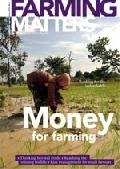Our readers write
We welcome comments, ideas and suggestions.
Send an e-mail to ileia[at]ileia.org or write to P.O. Box 2067, 3800 CB Amersfoort, the Netherlands.
Livestock services: free or fee? (1)
If livestock output is to be improved, farmers should be provided with free or highly subsidised livestock services, especially when it comes to animal health because peasant farmers constitute the major producers of food animals. And, in developing countries like Nigeria, they have the following features: They are into small-scale farming (livestock and crop); they are low-income earners; they are concentrated in rural and less-urban areas; they have little or no access to modern management techniques; they maintain their livestock mainly with forages, farm/domestic food wastes and no or low external inputs and no concentrates of compounded rations; they rear more, but with marginal outcome, and they have scarce or no access to livestock service providers because the majority of such providers detest working in local/remote communities.
Kazeem Akimboye, Department of Veterinary Public Health & Preventive Medicine, Nigeria, on our Open Forum
Livestock services: free or fee? (2)
Currently this service is free in Kenya but this has not helped poor farmers. This is because the officers sent by the government normally set up their own shops where they stock the necessary equipment and drugs. When farmers go to them for assistance, they are told to buy the needed drugs and syringes from their own shops, so you end up spending the same amount as if you had gone to a private practitioner. I think the best way to go about it would be to train para-vets in every locality, as some NGOs are doing. The para-vets should be provided with the most essential equipments and drugs. These people not only get a job, they provide the services near the people and at reasonable charges.
Stephen Kimole, Institute for Organic Farming, Kenya, on our Open Forum
Needed: a change in strategies
Billions of dollars are spent every year on food aid. Yet there are still more than one billion people suffering from hunger, and children suffering from malnutrition. Investment in smallscale farming and combining traditional farming methods with modern technologies adapted to local conditions, would create possibilities for sufficient local food and fodder production that would alleviate hunger. Offering families a small kitchen garden would eliminate child malnutrition in the shortest time. Return on investment would be remarkably high. Why not change strategies in our world food programmes.
Willem van Cotthem, Scientific Consultant for Desertification and Sustainable Development, Belgium, on our Open Forum
My dream
As a typical Ugandan poultry farmer, I enjoyed the theme overview in your livestock issue. I raise 350 laying chickens. I practise mixed farming whereby I grow bananas, maize and groundnuts. I use poultry manure for the bananas. I have four children. My dream is to become a successful poultry farmer in the Kayunga district, in central Uganda. What I would like is to be linked up with a successful poultry farmer elsewhere, who can be my role model and if possible can extend a helping hand in the extension of my poultry house project.
Richard Lubega, Uganda, through e-mail
Mistake
May I just make a minor correction to the article “Re-assessing the fodder problem” in your previous issue: Stylosanthes hamata is not a grass, it is a legume.
Oscar B. Posa, through e-mail
Keep it up
I find your magazine a very useful source of ideas and information concerning my work with natural resource management and rural development within Zimbabwe and the surrounding areas. I look forward to each new copy and my ambition one day is to be a contributor. Keep up the good work.
Robert Cunliffe, researcher, Zimbabwe, through e-mail

